They say… 
Best beer and travel writing award 2015, 2011 -- British Guild of Beer Writers Awards
Accredited Beer Sommelier
Writer of "Probably the best book about beer in London" - Londonist
"A necessity if you're a beer geek travelling to London town" - Beer Advocate
"A joy to read" - Roger Protz
"Very authoritative" - Tim Webb.
"One of the top beer writers in the UK" - Mark Dredge.
"A beer guru" - Popbitch.

|
Here’s a review of BSA and Wobble in a Bottle (also known as Santa’s Wobble) originally published in BEER April 2006, followed by an earlier review of Wobble from pioneering website the Oxford Bottled Beer Database, published on 23 March 2001.
Hogs Back is now one of the most successful breweries in southeast England, but neither of these beers is regularly available anymore as the brewery has gradually concentrated on high volume session beers like TEA. Wobble continued as a seasonal special for a while but hasn’t been seen for some years. The barley wine mentioned below, A over T, is still around however.
ABV 4.5 and 7.5 per cent
Origin Tongham, Surrey, England
Buy from specialist shops, brewery (tel 01252 784495)
Website www.hogsback.co.uk
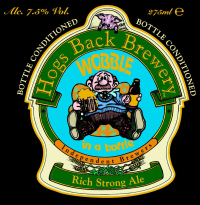 Hogs Back Wobble in a Bottle I’ve long regarded Hogs Back as one of Britain’s most outstanding bottled beer producers, so I was delighted to hear of its success at this year’s CAMRA Champion Winter Beer of Britain competition, where 9 per cent ABV barley wine A over T walked off with the top title.
The prize was awarded to the occasional draught version, but A over T is primarily a bottled beer. Unlike many brewers that simply bottle their draughts at typically British session strengths, Hogs Back is unafraid to offer beers at gravities of 7 per cent and up that show off the potential of unpasteurised ale to develop character in the bottle.
The expertise of Hog Back’s brewster Maureen Zeiher at the upper end of the gravity range invites comparison with the Belgian tradition of hefty regional specialities. Hogs Back’s strong beers, while unmistakeably English in style, are some of the few bottled beers from these islands that, in my view, can hold their own against the best of Belgian artisanal brewing in terms of quality, distinctiveness and complexity.
A comprehensive account of the history and background to the brewery can be found in last month’s Beer, and it’s worth noting from this that at Hogs Back they have always set providing quality and consumer choice above chasing the money by concentrating on mass-appeal brands.
Two other regular strong bottled beers are offered beside A over T: Brewster’s Bundle (7.4 per cent) and Wobble in a Bottle. All three are excellent but Wobble is my favourite. It originated as a Christmas beer, Santa’s Wobble, and has also spawned a draught summer variant, Still Wobbling. It has a classic English recipe of Maris Otter pale malt, crystal and chocolate malts, and Fuggles and East Kent Goldings hops.
It pours a pinkish mid brown, with a fine yellowish head and a delightfully fruity strawberry, orange and banana toffee aroma. The malty palate is sweetish at first but turns assertive and mouth-numbing, with complex spirit notes, figs and a hint of toasted coconut, lifted by nicely balanced hops.
Broad strokes of toasty malt and fig rolls make for a rounded and long-lasting finish with a vivid peppery bitterness far back in the throat. Overall a splendid strong beer: my young sample bottle was already smooth and integrated, but would have developed further for a good year in the bottle.
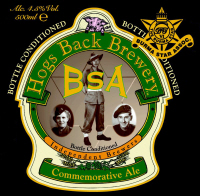 Hogs Back BSA The brewery is by no means limited to beers for sipping as a postprandial or bedtime treat, however: there are also lower gravity brews that still acquit themselves well in the bottle, such as BSA or Burma Star Ale.
Brewed to a similar recipe to Wobble, BSA comes out a brilliant reddish amber with a good white head. A malty aroma with minerally wet stone notes and a squeeze of citrus leads to a crisp biscuity malt palate, with more fruity citrus, crystal malt and tannic hops.
A drying swallow heralds a leafy hop finish with a good dose of peppery bitterness over smooth fresh malt. This is another well-integrated and very drinkable beer with lots to say for itself.
A share of the profits goes to the Burma Star Assocation, a welfare organisation for servicemen and women involved in the Burma Campaign during World War II, such as brewery co-founder Martin Zillwood-Hunt’s father, who features on the label.
Visit the brewery at its attractive site in converted farm buildings near Farnham, right by the narrow chalk ridge from which it takes its name, and you’ll also find one of the country’s best speciality beer shops, stocking an excellent range of British and imported beers. Here, Hogs Back’s own products line up confidently to take a well-deserved place beside some of the best beers in the world.
OBBD review, 26 March 2001:
This Surrey micro, named after a local geological feature, is best-known for its award winning TEA (Traditional English Ale) but also produces a range of bottle-conditioned ales, many of which are on the strong side, including this piece of festive fallout: it originated as a draught seasonal beer called Santa’s Wobble but the bottled version is available all year round.
It’s a rich ruby brown in colour, with a smooth head and a perfumed hoppy aroma featuring spices and raspberry-like esters: whole English hops are used. The palate is very full and malty, smooth and rich and fruity rather than nutty, with traces of brazils and marzipan. The bitterness, when it comes, is well-balanced, and the resulting beer is a little heavy but not really cloying, finishing with lots of hops.
Some strong beers from mainland Europe are very upfront with their complex array of flavours, but Wobble in a Bottle has a very British restraint, and its own subtle complexity unwinds slowly as you sip your way through the glass. It might wobble, but it certainly doesn’t fall down.
Originally published in BEER March 2006
Beer sellers: Meadow Farm Shop
See previous post for more Welsh beers. Note Cwrw Castell has since been discontinued.
ABV 3.8 and 5.6 per cent
Origin Conwy Town, Conwy, Wales
Buy from local outlets, brewery (tel 01492 585287)
Website www.conwybrewery.co.uk
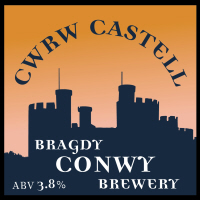 Conwy Cwrw Castell At the opposite, northern end of Wales is another relatively new micro that takes its bottling seriously. Set up by former home brewer Gwynne Thomas in 2003 and originally experimenting with bottling off site, it now boasts its own bottling line installed with the aid of a grant from the Welsh Assembly Government.
Now all the beers are available in both cask and bottle conditioned form, and the bottles do well in local outlets, including restaurants, hotels and even youth hostels, venues that wouldn’t take cask ale but are still keen to offer guests a distinctive quality local product. The Spar convenience store chain has also been helpful and numerous local branches take the beers.
Cwrw Castell, or Castle Bitter for those who can’t handle w’s used as vowels, commemorates Conwy’s most celebrated landmark, the 13th century castle that is now a World Heritage Site. It’s a good ordinary bitter made with traditional floor malted barley, Pioneer hops in the copper and Cascade for the aroma.
This is a rich golden amber beer with off-white lace and a cheerful flowery geranium and blackcurrant aroma with just a touch of sulphur. The light sweetish palate has lots of fruit and a very faint roast note, developing orange and other citrus flavours and ginger syrup with a good brush of hops.
The lingering finish is tangy with the blackcurrant notes returning over biscuity malt and gently bittering hops. Again a straightforward beer, and at a quaffing gravity, but cheerful and very enjoyable.
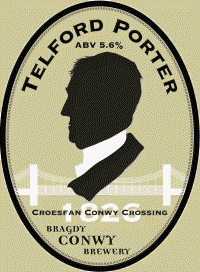 Conwy Telford Porter Telford Porter is a quite different proposition: a strongish brew lent a dark reddish brown colour by dark malts and roasted barley, with a smooth off-white head. The aroma is gently fruity, roasty and slightly oily.
You can taste the roast on a dryish and herbal palate with distinct liquorice notes and a dash of brown sugar – I also detected something like that old fashioned soft drink, Dandelion and Burdock.
The finish starts pleasantly fruity and turns tangily drying, with more roast, burry hops and those persistent herbal flavours again, plus a touch of floweriness. Overall this is a subtle beer that captures the style but lacks the aggressive flavours of some modern porters.
Intriguingly, Telford Porter is subtitled “Historic Ale No. 1” – Gwynne aims to produce a series of beers linked specifically to the history of Conwy. This one pays homage to the beers that might have been drunk when Thomas Telford built the famous suspension bridge across the river Conwy to the castle back in 1826.
Recognising that dark, strong beers based on old recipes might delight knowledgeable beer lovers without setting the mass market alight, the brewery didn’t expect vast sales for the porter – but in fact it’s proved one of their more successful lines.
No doubt one of the reasons was the explicit link to local heritage. The beer is a great example of a microbrewery making the most of its strengths by producing a quality product that unashamedly carries a sense of origin and place, in direct opposition to the sort of brewer that thinks it doesn’t matter if a beer named after its home town of Hoegaarden is brewed in Jupille. Iechyd da!
Read more about these beers at ratebeer.com:
http://www.ratebeer.com/beer/conwy-castle-bitter-cwrw-castell/30814/
http://www.ratebeer.com/beer/conwy-telford-porter/54050/
Originally published in BEER March 2006.
Beer sellers: Meadow Farm Shop
ABV 4.5 and 4.7 per cent
Origin Brecon, Powys, Wales
Buy from specialist shops, brewery (tel 01874 623731)
Website www.breconshirebrewery.com
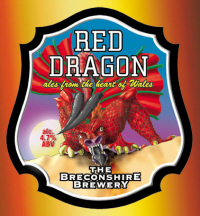 Breconshire Red Dragon With St David’s Day imminent as this issue hits the shelves, this month’s column finds a welcome in the hillside for real ale in a bottle with two small breweries that are relatively new and notably enthusiastic exponents of fine bottle conditioned beers.
The Breconshire Brewery, in the idyllic setting of the northern edge of Brecon Beacons national park, originated in 2002 when well-established distributor and wholesaler C H Marlow decided to experiment with offering its own beers alongside other people’s.
With kit from the defunct Pembrokeshire Brewery and a brewer, Justin Grant, rescued from the ruins of Brakspear, the brewery was soon winning prizes for its tasty draught beers: its standard bitter, Brecon County Ale, was recently named best in class at CAMRA’s Champion Beer of Wales competition for the third year running.
Bottling followed in 2004, originally off site, and the range has expanded with a number of imaginative and interesting lines, most of which I tasted for this column. Given my other life as an employee of a national walking organisation, I was tempted to feature strong bitter Ramblers Ruin (5 per cent ABV) but the two most enjoyable of the bottles turned out to be a great best bitter and an unusual red ale.
Brecknock Best is a celebration ale brewed to mark the 250th anniversary of the Breconshire Agricultural Society, the oldest organisation of its kind in Britain. Like all the brewery’s beers it features floor malted Optic barley, in this case hopped with Pilot and the distinctive Bramling Cross.
It’s a classic deep amber colour, showed off to good effect with my bottle which poured obligingly clear. An inviting fruit salad aroma with hints of yeast and sulphur leads to a beautifully fresh palate that’s chewy and malty with roasty and spicy notes.
A tingly swallow is followed by a rounded, well-balanced finish that develops a lightly bitter sting and some juicy, slightly astringent grapefruit notes. Some cherry flavour and close maltiness are apparent later.
This is a straightforward and not especially complex beer, but it’s beautifully balanced and provides easy and delightful drinking. The Agricultural Society should feel complimented by such a fine brew, which has now become established as a regular line.
More unusual is Red Dragon, which links the mythical beast from the Welsh flag with wider Celtic references by nodding to the Irish tradition of malty red ales, throwing in a hint of the dry, sappy red-brown ales of northeast England for good measure. The recipe includes generous quantities of crystal malt, alongside Pioneer and 93/50 hops.
The beer pours a slightly cloudy rich cherry red, with a foamy off-white head. A complex nutty, spicy and fruity aroma includes almond tones. It’s smooth in the mouth, nutty, woody and slightly musty, reminiscent of the signature of wild yeast with a sprinkling of twiggy fennel notes.
A chocolatey swallow leads to a hoppy roasted peanut finish that develops an astringent dryness and deep spicy notes. A pleasingly distinctive bottleful that doesn’t taste quite like anything else I’ve encountered, although the influence of the likes of Double Maxim and Newcastle Brown is evident.
More Welsh beers reviewed in next post.
Read more about these beers at ratebeer.com:
http://www.ratebeer.com/beer/breconshire-brecknock-best/46512/
http://www.ratebeer.com/beer/breconshire-red-dragon/34606/
Originally published in BEER February 2006.
To read about more beers stocked by Morrisons, see previous post.
ABV 7 per cent
Origin Arcen, Limburg, the Netherlands
Buy from Morrisons
Website www.hertogjan.nl
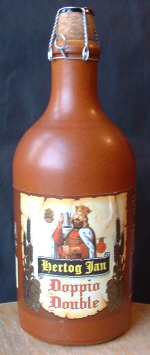 Hertog Jan Dubbel The Arcense Stoombierbrouwerij (Arcen steam brewery) in hilly Limburg dates back to 1915. Relaunched with a management buyout in 1981, it was at first prevented under the terms of the sale from making lager-style beers, so the new owners concentrated on developing the speciality ale market, becoming pioneers of the new wave of Dutch brewing.
The brand, Hertog (Duke) Jan, underlined a Belgian influence by alluding to Duke John I of Brabant (ruled 1267-94), also known as Gambrinus, the King of Beer. With its beers stocked in supermarkets throughout the Netherlands as a home-grown answer to imported Belgian brews, the brewery soon caught the beady eye of the multinationals and is now in Interbrew’s hands.
Dubbel, now stocked by Morrisons in 50cl ceramic crocks, is an abbey-style dark ale made with roasted malt, malted wheat, brewing sugar and caramel colouring. It pours a deep reddish brown, with a nice soft fawn head and a chocolate roast aroma with herbal notes and a sharp tang.
The palate is soft but dry and coffeeish, with restrained doses of sharp hops, roast and herbs and a touch of chocolate syrup. There’s a malty, tangy finish with faint roast tones and some pleasant raisiny notes. Not the best example of an abbey double by any means, but new to the UK market, bottle conditioned and decent enough.
Among others worth investigating on the Morrisons list are Vienna-style 1664 Premier Cru, Schneider and Franziskaner wheat beers from Bavaria, and California’s Sierra Nevada pale ale. British Real Ale in a Bottle is currently limited to Coniston Bluebird, Brakspear Organic and Hopback Summer Lightning, good beers all, with Innis & Gunn and Marstons Old Empire noteworthy among the filtered ales.
Read more about this beer at ratebeer.com: http://www.ratebeer.com/beer/hertog-jan-dubbel/5303/
Originally published in BEER February 2006.
To read about more beers stocked by Morrisons, see previous post.
ABV 6.5 per cent
Origin Berkel-Enschot, North Brabant, the Netherlands
Buy from Morrisons, other supermarkets and specialist shops
Website www.latrappe.nl
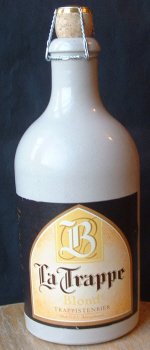 Koningshoeven La Trappe Blond In October 2005 the number of official Trappist breweries in the world rose from six to seven, with the only such monastery brewing commercially outside Belgium given the right to use the official Trappist seal once more.
Since its first beers emerged in 1885, the history of the brewery at the abbey of Our Lady of Koningshoeven, 3km outside Tilburg, has been complicated. Originally branded Schaapskooi, since 1980 the traditional monastic-style ales have borne the name La Trappe (Koningshoeven in North America), but other styles of beer have been produced under different names.
Twice, secular brewers have been involved: Interbrew’s predecessor operated the brewery between 1969 and 1980 and it was leased to Dutch national brewer Bavaria in 1998, which led to the withdrawing of the Trappist seal by the International Trappist Association – it’s not clear whether the abbey asked for this or was forced to accept it.
In any case, last year the ITA re-examined the deal with Bavaria and found that since the monks maintain control of the La Trappe brands, these beers if not the brewery’s other products should be entitled to display the coveted seal.
It might be heresy to say so, but the blond ale, which replaced a nondescript beer called Enkel (single) and is now stocked by Morrisons in 50cl ceramic crocks, is a good example of how the brews have improved since Bavaria’s involvement.
This bottle conditioned beer pours a slightly cloudy rich golden with a pillowy white head that leaves a good lace. There’s a spicy hop aroma with fennel notes and a slight phenolic character with banana and pineapple.
More fruity banana follows in a dryish and nicely malty palate with tart fruit, spices and vanilla cream emerging. The tangy finish has some pleasing hopsack notes with pineapple and custard. Leffe Blond might be like this if it was made by a brewery that cared.
Look out at specialist retailers for the rest of the range: Dubbel, Tripel, Quadrupel (10 per cent ABV), and a new Trappist wheat beer.
Read more about beers stocked by Morrisons in the next post.
Read more about this beer at ratebeer.com: http://www.ratebeer.com/beer/la-trappe-blond/10380/
Originally published in BEER February 2006
ABV 5.5 per cent
Origin Purnode, Namur, Belgium
Buy from Morrisons, specialist shops
Website www.bocq.be
 Du Bocq La Gauloise Ambrée In March 2004, when Yorkshire-based grocer Morrisons turned itself into the fourth largest supermarket chain in the UK by swallowing up rival Safeway and converting all its stores, the news was greeted with some alarm by bottled beer lovers: of all the national chains Safeway had boasted easily the most interesting beer range.
Last Autumn Morrisons went some way to making up the loss by launching a range of over 20 imported specialities, but hardened beer hunters hoping for the sort of surprises Safeway once served up may be disappointed by a list heavy on Interbrew and S&N/Kronenbourg brands and beers already fairly widely available in Britain.
La Gauloise Ambrée, a bottle conditioned Belgian amber ale from an old-established family-owned Wallonian independent, is one of the more interesting inclusions. Brewery Du Bocq specialises in decent warm fermented beers, though an irritating habit of marketing identical brews under different names hasn’t helped its reputation with beer lovers.
The Ambrée is one of a series of three Gauloise beers with labels depicting the classical goddess of grain Ceres. Though the label claims this is “the beer of our ancestors”, the recipes are modern. The advised serving temperature of 5°C should be taken even less seriously – it’s far too low in my opinion.
This is a cheerful enough lightly spiced ale that pours clear and sparkling from its corked 750ml bottle, with a rich amber colour (30 EBC) and a fluffy off-white head. Herbs including coriander show in the spicy, mallowy aroma.
There’s plenty of juicy sweet malt, drying hops and herbal flashes on the palate but also a papery note. The finish is the beer’s strongest suit: it’s tangily fruity with rounded burry hops (30 IBU) and a ginger cake touch.
The blond and brown sister beers are not stocked by Morrisons but often pop up in specialist shops – the brown is the strongest and best of the three.
See next post to read about more beers stocked by Morrisons.
Read more about this beer at ratebeer.com: http://www.ratebeer.com/beer/la-gauloise-ambree/6152/
First published in BEER March 2007
ABV: 4.8 and 5 per cent
Origin: Newquay, Cornwall
Buy from: Local outlets, specialists
Website: www.atlanticbrewery.com
 Atlantic Blue, Red and Gold Meanwhile, Britain’s other Celtic peninsula is providing ever richer pickings for the beer connoisseur [see previous post reviewing two Welsh beers], with one of our few remaining traditional regionals, St Austell, going from strength to strength and outstanding newcomers like Sharps and Skinners also making their mark.
Atlantic, a brewery specialising in organic Real Ale in a Bottle located near Newquay on the coast of the eponymous ocean, is one of the most recent startups, dating from 2005. Judging by the two excellent beers I tasted for this piece, it should have a great future.
Remarkably, Atlantic grows its own hops and also produces special malts as well as brewing and bottling in-house – a level of vertical integration that was common in pre-industrial days but is very rare now.
Atlantic’s cottage industry status was confirmed when I phoned and was told brewer Stuart Thomson couldn’t speak to me as he was literally in the mash tun. I assume it was empty at the time and this wasn’t some experiment with unusual adjuncts!
All the beers are packaged in 330ml clear glass bottles – elegant but looking worryingly like alcopops. Anyone expecting from its name that Atlantic Blue might also resemble some of the sillier alcopops in colour will be reassured to know it’s actually a sensible dark ruby brown, and pours with a fine yellowish head.
A smooth dark malt and liquorice aroma leads to a light textured but very flavoursome palate with roast malt, sharpish fruit, fresh coffee, burnt toast and a faint medicinal note. The finish is rather sternly dry, roasty and hoppy but softened by flashes of juicy raisin fruit.
Crystal, chocolate and black malt provide the colour and there’s a dash of wheat malt too, with Fuggles and First Gold hops.
Brewed to a similar recipe but without the darker malts, Red Organic Celtic Ale does some pan-Celtic borrowing from Irish styles to create a very tasty reddish-amber beer with a soft and sticky off-white head, and a nutty and resiny aroma with hints of autumn fruit.
The palate is nicely fruity and slightly phenolic, with marmalade and hop resins over chewy malt. An initially soft finish soon turns moreishly hoppy with a touch of ginger spice and lingering orange peel. Yeghes da!
Read more about these beers at ratebeer.com:
http://www.ratebeer.com/beer/atlantic-blue/51066/
http://www.ratebeer.com/beer/atlantic-red/62999/
First published in BEER March 2007
ABV: 3.7 and 4.6
Origin: Porthmadog, Gwynedd, Wales
Buy from: Local outlets, specialists
Website www.purplemoose.co.uk
 Mŵs Piws Cwrw Madog The daffodils are blooming, the days are getting longer and Gŵyl Ddewi is upon us – time to celebrate the coming of spring with a glass of cwrw cymreig da.
Wales has a reasonable sprinkling of craft brewers offering Real Ale in a Bottle, most of them very small producers trading through local outlets and farmers markets. It’s a sector where distinctiveness and provenance matter to the consumer, especially in a part of Britain with its own separate and strong national identity.
So it’s pleasing to see so many beer bottles flying the Red Dragon and bearing the Welsh language, alongside more local references to the geography and history of brewery sites.
Porthmadog’s Bragdy Mŵs Piws is a good example. The name – Purple Moose – is a little puzzling as Gwynedd is rather out of range of any kind of moose, let alone a purple one. But founder Lawrence Washington, who first used the name on his home brew, says purple is his favourite colour and everyone loves a moose.
Lawrence conceived the brewery while based in Cheltenham, and it was a connection with the Ffestiniog railway that led him to choose Porthmadog as a location when he went commercial in 2005. He’s been picking up SIBA and CAMRA awards for his cask beer ever since.
The beers are proud to celebrate their home town, a small port on the Irish Sea coast and the edge of Snowdonia, founded in the early 19th century by landowner and agricultural improver William Madocks, who reclaimed land at the estuary of the afon Glaslyn.
The town’s founding father is namechecked in Cwrw Madog. Two varieties of crystal malt give a reddish-amber glow to a Maris Otter grist, with a bubbly off-white head and a broadly malty aroma with a touch of earthy hops and fruit salad. The palate is very dry and tannic with oily hop resins – Pioneer and Goldings –over light fruit.
There’s an unusual and interesting paraffin-like note on the swallow, leading to a resiny and peppery bitter finish with pleasant fruit and long lasting hops. Overall this is a rich and flavoursome bitter on the hoppier side of the style.
 Mŵs Piws Ochr Tywyll y Mŵs An obvious fondness for hop bitterness expresses itself across the Purple Moose range, even in dark ale Ochr Tywyll y Mŵs – Dark Side of the Moose in English. This is a deep amber-brown ale with a loose and bubbly head, again with crystal and dark crystal malts and a dash of roasted barley.
A spicy coffee aroma introduces a roasty palate with cola notes and a surprisingly hefty dose of Pioneer and Bramling Cross hops, with the sort of citric, pineapple and blackcurrant tones that are more usually found in paler summer ales.
It’s an intriguing and surprisingly successful combination that also includes a touch of powder-dry plain chocolate, and more blackcurrant on a very long finish with burnt roast flavours.
These are bottle conditioned beers, but be warned that Lawrence is planning to introduce contract-bottled filtered (though unpasteurised) versions alongside his RAIBs in future. This is in response to demand from some local restaurants whose staff and customers can’t quite get their head round the idea of a sediment yet.
I admit I have some sympathy with craft brewers considering filtering bottled ales. I’d originally planned to feature a second small Welsh RAIB producer this month, but every one of four different bottles I sampled was off.
Read more about these beers on ratebeer.com:
http://www.ratebeer.com/beer/purple-moose-madogs-ale-cwrw-madog/50456/
http://www.ratebeer.com/beer/purple-moose–dark-side-of-the-moose-ochr-tywyll-y-mws/53618/
Originally published in BEER April 2006
CAMRA North London tasting 2010
ABV: 4 and 4.2 per cent
Origin: Cropton, North Yorkshire, England
Buy from: Local Tesco, specialists
Mail order: 01751 417330, www.croptonbrewery.com
 Cropton Two Pints From Jacobite Ale [see previous post] to a brewery offering a beer called King Billy might once have seemed a jump too far, but anyone who appreciates great beer should find room for them both. Cropton is an outgrown brewpub dating from 1984 and based at the New Inn pub in a tiny village near Pickering in the North York Moors national park.
Its range of nine bottled beers are all bottle conditioned and all vegetarian and vegan. The ones I’ve tried are distinctive and packed full of flavour, and you can shop for a mail order mixed case on the web or over the phone.
Two Pints Bitter was the brewery’s first brew as a draught beer, so named because it was so good that drinking one pint was as good as drinking two. It’s a rich lively golden colour with a fine but low white head and a tart spiced apple and blackberry aroma, made from pale and crystal malt and hopped with Challenger and East Kent Goldings.
A dry, slightly milky and nicely biscuity palate has blackcurrant notes, with a bitter sting in the swallow leading to a delicate leafy finish with slight roasty notes. This is a subtle, elegant and very refreshing beer with an exquisite balance.
 Cropton Scoresby Stout Scoresby Stout is a more robust beer taking its name from a local whaling captain who is credited with inventing the crow’s nest. This adds roasted barley to a grist similar to Two Pints, to produce a very dark brown beer with a thick brown head subsiding to bubbly lace.
The aroma is relatively restrained, with malt, dark sugar, roast and cola, followed by lots of fruit on a very tangy palate with the sting of roasted barley. There’s charred wood well-blended with malt and a moreish touch of hop bitterness on the rounded finish.
At the CAMRA North London tasting in February 2010 we started with Two Pints, which was generally enjoyed as a well balanced straightforward session beer, although with a notably short finish with little hop character.
Read more about these beers at ratebeer.com:
http://www.ratebeer.com/beer/cropton-two-pints-bitter/6685/
http://www.ratebeer.com/beer/cropton-scoresby-stout/6695/
Originally published in BEER January 2006
ABV: 7.2 and 8 per cent
Origin: Traquair, Scottish Borders, Scotland
Buy from: Specialists
Website: www.traquair.co.uk
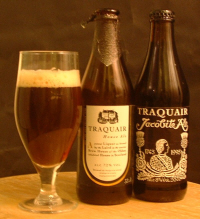 Traquair House Ale and Jacobite Ale Scotland also offers a few filtered bottled beers of note: for example, Williams Brothers Heather Ale range, which includes the unhopped Alba Ale; the wood-matured Innis & Gunn; or Orkney Brewery’s barley wine, Skullsplitter. But outstanding among all of them are the beers of Traquair House, the country’s oldest established micro based in its oldest-inhabited castle.
The brewhouse at Traquair, so the romantic story goes, was rediscovered with equipment intact by the laird, Peter Maxwell Stuart, in 1965, and since his death in 1990 has been run by his daughter Catherine. The principal beer, simply called Traquair House Ale, is an acknowledged classic, made with malt from Hugh Baird in East Lothian and East Kent Goldings hops, filtered but unpasteurised and capable of developing with age.
A five-year-old bottle from my cellar poured a very dark ruby brown with a soft, fine and very persistent yellowish head. A potent amontillado sherry aroma with woody hints led to a generous and very complex palate with dark sherryish fruit, well-rounded sour roasty notes and a hint of artichoke.
A lightly warming and gently mouth-tingling finish had burnt raisins, chocolate milk, burry hops, spices and orange fruit. This is a complex and intoxicating beer that you’d be a fool to turn your back on since it doesn’t technically qualify as “real”.
At Traquair the family sympathies lay with the Jacobite cause: Charles Edward Stuart stayed at the castle in 1745, and having closed the distinctive Bear Gates behind him, the laird vowed not to open them again until a Stuart returned to the throne. The gates remain closed, but the link is now celebrated in the spiced Jacobite Ale, first produced in 1995 to commemorate 250 years since the rebellion.
Also a dark brown and with a very light sparkle, this beer has a blackcurrant pastille and herb aroma and a lacy off-white head. The richly malty palate is sweetish on the lips but well-balanced by a slight sourness and emerging herbs, especially coriander.
The dry finish still has a syrupy feel, and a long, subtle development with unwinding herbal flavours. Perhaps not as impressive as the regular Ale, this is still worth getting to know as one of Britain’s most successful spiced beers.
Read more about these beers at ratebeer.com:
http://www.ratebeer.com/beer/traquair-house-ale/2012/
http://www.ratebeer.com/beer/traquair-jacobite-ale/5711/
|
Cask  This pioneering new book explains what makes cask beer so special, and explores its past, present and future. Order now from CAMRA Books. Read more here. This pioneering new book explains what makes cask beer so special, and explores its past, present and future. Order now from CAMRA Books. Read more here.
London’s Best Beer  The fully updated 3rd edition of my essential award-winning guide to London’s vibrant beer scene is available now from CAMRA Books. Read more here. The fully updated 3rd edition of my essential award-winning guide to London’s vibrant beer scene is available now from CAMRA Books. Read more here.
|


















